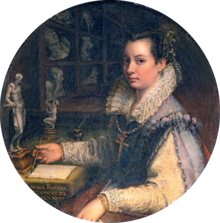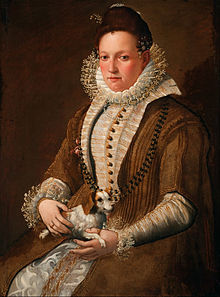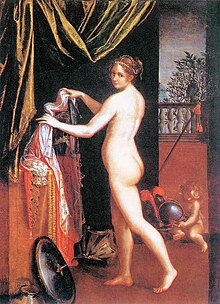Lavinia Fontana: Difference between revisions
→top: add per body |
|||
| Line 15: | Line 15: | ||
| alma_mater = [[University of Bologna]] |
| alma_mater = [[University of Bologna]] |
||
| style = Mannerist |
| style = Mannerist |
||
| spouse = {{marriage|Gian Paolo Zappi|June 1577}} |
|||
| children = 11 |
|||
| elected = [[Accademia di San Luca]] |
| elected = [[Accademia di San Luca]] |
||
| patrons = {{cslist|[[Pope Gregory XIII]]|[[Pope Clement VII]]|[[Pope Paul V]]}} |
| patrons = {{cslist|[[Pope Gregory XIII]]|[[Pope Clement VII]]|[[Pope Paul V]]}} |
||
Revision as of 23:48, 25 August 2023
Lavinia Fontana | |
|---|---|
 Self-Portrait in the Studio, 1579 | |
| Born | |
| Baptised | 24 August 1552 |
| Died | (aged 61) Rome, Papal States |
| Resting place | Santa Maria sopra Minerva, Rome |
| Education |
|
| Alma mater | University of Bologna |
| Style | Mannerist |
| Spouse |
Gian Paolo Zappi (m. 1577) |
| Children | 11 |
| Father | Prospero Fontana |
| Elected | Accademia di San Luca |
| Patron(s) | |
Lavinia Fontana (24 August 1552 – 11 August 1614) was a Bolognese Mannerist painter active in Bologna and Rome. She is best known for her successful portraiture, but also worked in the genres of mythology and religious painting. She was trained by her father Prospero Fontana who was a teacher at the School of Bologna. She is regarded as the first female career artist in Western Europe as she relied on commissions for her income.[1][2] Her family relied on her career as a painter, and her husband served as her agent and raised their 11 children.[3] She was perhaps the first woman artist to paint female nudes, but this is a topic of controversy among art historians.[4]
Biography
Lavinia Fontana was born in Bologna in 1552[5] to Prospero Fontana and Antonia de' Bonardis. She was baptized on 24 August 1552, at the cathedral of San Pietro.[6] Her elder sister Emilia died in 1568 when Lavinia was sixteen. Prospero was a prominent painter of the School of Bologna at the time and served as her teacher. Caroline P. Murphy suspects that financial issues may have prompted Prospero to train Lavinia as a painter.[7] Being born as the daughter of a painter allowed her to become an artist in a time where female artists were not widely accepted.[8] Fontana married Gian Paolo Zappi. Instead of offering a dowry as would have been widely accepted in this time Fontana painted to earn an income.[9]


Her earliest known work, Child of the Monkey, was painted in 1575 at the age of 23. Though this work is now lost, another early painting, Christ with the Symbols of the Passion, painted in 1576, is now in the El Paso Museum of Art.[11] Bolognese society at large was supportive of Fontana's artistic career, providing opportunities and connections that were not available to women in other locales.[12] She began her commercial practice by painting small devotional paintings on copper, which had popular appeal as papal and diplomatic gifts, given the value and lustre of the metal.[1] In the 1580s, she was known as a portraitist of Bolognese noblewomen who competed for her services. The high demand for portraits painted by Fontana was reflected in the large sums of money she earned during this period.[13] Her relationships with female clients were often unusually warm; multiple women who sat for portraits, such as the Duchess of Sora Constanza Sforza Boncompagni, later served as namesakes or godmothers for Fontana's children.[14] In addition to portraits, she later created large-scale paintings with religious and mythological themes which sometimes included female nudes.[2]
Fontana married Gian Paolo Zappi (alternate spellings include Giovan and Fappi) in June 1577. The couple moved into Prospero's house in Bologna and Lavinia painted professionally, adding Zappi to her signature.[15] She gave birth to 11 children, though only 3 outlived her: Flaminio, Orazio, and Prospero.[16] Zappi took care of the household and served as an agent and painting assistant to his wife, including painting minor elements of paintings such as draperies. Fontana attended classes at the University of Bologna, and was listed as one of the city's 'Donne addottrinate' (women with doctorates) in 1580.[17][18]

Roman period (1603-14)
Fontana and her family moved to Rome in 1604 at the invitation of Pope Clement VIII. She gained the patronage of the Buoncompagni, of which Pope Gregory XIII was a member. She was subsequently appointed as Portraitist in Ordinary at the Vatican.[19] Lavinia thrived in Rome as she had in Bologna and Pope Paul V himself was among her sitters. She was the recipient of numerous honors,[2] including a bronze portrait medallion cast in 1611 by sculptor and architect Felice Antonio Casoni.[20] According to Jean Owens Schaefer, the reverse side of the medal depicts Pittura, an allegorical figure representing painting. He also posits that this is the first visual rendition of Cesare Ripa's 1603 description of Pittura.[21]


She was elected into the Accademia di San Luca of Rome. She died in the city of Rome on 11 August 1614, and was subsequently buried at Santa Maria sopra Minerva.
Legacy
The Self-Portrait at the Clavichord with a Servant is considered to be her masterpiece. It was painted as a betrothal gift to the Zappi family as evidenced by Fontana describing herself as a virgin in the signature and stating that she painted while looking at herself in a mirror as a testament to the accuracy of the depiction. There are over 100 works that are documented, but only 32 signed and dated works are known today. There are 25 more that can be attributed to her, making hers the largest oeuvre for any female artist prior to 1700. Some of her portraits were once wrongly attributed to her contemporary Guido Reni.
Lavinia's mythology paintings which feature nude figures are being increasingly studied by art historians. Roman gods such as Minerva, Mars, and Venus are depicted in various forms of undress in these paintings. There is little or no basis for other contemporary women artists depicting nude figures in such a way.[22] It has been said that Fontana's work with mythology painting represents possibly the first female artist involvement in the genre.[23]
Lavinia is immortalized as the subject of Portrait of a Woman (1595) by Paolo Veronese.[24] She was the only woman artist featured in Giulio Mancini's Considerazioni sulla pittura (Considerations on Painting). The naturalism of her paintings is highly praised and the beauty of her paintings is linked to her own physical attractiveness.[25]
Fontana influenced Alberto de' Rossi and Alessandro Tiarini. Aurelio Bonelli may have studied under her.[26] She was a very successful artist who was well commissioned and was able to financially profit from her art. She is a rare example of a woman able to obtain such high levels of success in art during the Renaissance period. Her close attention to detail displayed the wealth of the sitter, and this is what made her so popular among the rich.[27]
Artistry
Artistic influences
Lavinia's youthful style resembled that of her father, Prospero. As a student of Ludovico Carracci, she gradually adopted the Carracciesque style, with strong quasi-Venetian coloring.[1]
Sofonisba Anguissola, Caterina Vigri, and Properzia de' Rossi may have influenced Fontana's artistic career.[28]
The Counter-Reformation and the Council of Trent's recommendations for religious art defined Fontana's treatment of subjects and themes in her paintings (see Rocco, Devout Hand for more on this topic). Excellent status as a daughter, wife, and mother was a prerequisite to her career due to the moral standards of the day.[28] Demand for portraits of family and children rose due to the Roman Catholic Church's emphasis on family values.[29]
Style
The influence of Mannerism is noticeable in Fontana's close attention to detail in her paintings and the significance of the materials surrounding the subject.[30] Fontana's self-portraiture strikes a balance between presenting the artist as a distinguished lady and as a professional artist. This depiction of two coexisting roles was common for sixteenth-century women artists.[31]
Controversy
Nudity

Among art historians, there is a controversy over Fontana's depiction of the nude female, and male form in her paintings.[1] Liana De Girolami Cheney argues that the naturalism of the figures may indicate that Fontana used live nude models.[32] Caroline P. Murphy argues that while body parts are well rendered, the figures as a whole are disproportionate, similar to Prospero's rendering of human anatomy. Additionally, Murphy points out that during Lavinia's lifetime, it was socially unacceptable for women to be exposed to nudity; if it was discovered that she used live nude models, her reputation would be tarnished. She instead suggests that like Sofonisba Anguissola, Fontana had family members model for her.[33] Further, Linda Nochlin explains that the art academy barred women from viewing any nude body, despite this being a crucial part of training.[34]
Major works
- Self-Portrait with the Spinet Accompanied by a Handmaiden, 1577 – Accademia Nazionale di San Luca, Rome
- Self-Portrait with Palette and Brushes, 1579
- Portrait of a Noblewoman, c. 1580 – National Museum of Women in the Arts, Washington, D.C.
- Portrait of a Couple, 1580–1585 – Cleveland Museum of Art, Cleveland
- The Dead Christ with Symbols, 1581 – Cornell Fine Arts Museum,[11] Winter Park, Florida
- Newborn Baby in a Crib c. 1583 – Pinacoteca Nazionale di Bologna
- Portrait of the Gozzadini Family, 1584 – Pinacoteca Nazionale di Bologna
- Portrait of Gerolamo Mercuriale, c. 1587–1590 – Walters Art Museum, Baltimore
- Holy Family, 1589 – El Escorial, Outside Madrid
- Portrait of a Lady with Lap Dog, c. 1595 – Walters Art Museum, Baltimore
- Portrait of Costanza Alidosi, c. 1595 - National Museum of Women in the Arts, Washington, D.C.
- The Visit of the Queen of Sheba to King Solomon, 1599, – National Gallery of Ireland, Dublin
- Birth of Virgin – Santissima Trinità, Bologna
- Consecration to the Virgin – Musee des Beaux-Arts, Marseilles, originally the Gnetti Chapel, Santa Maria dei Servi, Bologna
- Jesus among the Doctors and Coronation of the Virgin – Part of the Mysteries of the Rosary in the Rosary chapel in the Basilica of San Domenico, Bologna
- Minerva Dressing, 1613 – Galleria Borghese, Rome
- Mars and Venus, c. 1600-1610 – Fundación Casa de Alba, Madrid
-
Mystic marriage of Saint Catherine, 1574-77 – National Gallery of Victoria, Melbourne
-
Assumption of the Virgin with Saints Peter Chrysologus and Cassian, 1584 – Palazzo Comunale, Imola
-
Noli me tangere, 1581 – Uffizi, Florence
-
Ritratto della famiglia Maselli, c. 1565–1614, oil on canvas
See also
- Women Artists
- Invisible Women: Forgotten Artists of Florence
- Sofonisba Anguissola
- List of Italian women artists
- Italian Renaissance painting
Notes
- ^ a b c d Murphy, Caroline P. (2003). Lavinia Fontana: A Painter and Her Patrons in Sixteenth-Century Bologna. New Haven, CT: Yale University Press. p. 30. ISBN 978-0-300-09913-3.
- ^ a b c "Artist Profile: Lavinia Fontana". National Museum of Women in the Arts. Retrieved 29 March 2013.
- ^ Weidemann, Christiane; Larass, Petra; Melanie, Klier (2008). 50 Women Artists You Should Know. Prestel. pp. 18, 19. ISBN 978-3-7913-3956-6.
- ^ De Girolami Cheney, Liana (2015). "Lavinia Fontana's nude Minervas". Woman's Art Journal: 32. ISSN 0270-7993. OCLC 956553105.
- ^ Great Women Artists. Phaidon Press. 2019. p. 140. ISBN 978-0714878775.
- ^ Murphy, Caroline P. (2003). Lavinia Fontana: A Painter and Her Patrons in Sixteenth-Century Bologna. Singapore: Yale University Press. p. 18. ISBN 978-0-300-09913-3.
- ^ Murphy, Caroline P. (2003). Lavinia Fontana: A Painter and Her Patrons in Sixteenth-Century Bologna. Singapore: Yale University Press. pp. 20–1. ISBN 978-0-300-09913-3.
- ^ "Lavinia Fontana: Renaissance Artist". Smith College Museum of Art. 5 December 2019. Retrieved 9 March 2021.
- ^ M., Bohn, Babette, 1950- Saslow, James (2013). A companion to Renaissance and Baroque art. Wiley-Blackwell. ISBN 978-1-118-39150-1. OCLC 929654491.
{{cite book}}: CS1 maint: multiple names: authors list (link) CS1 maint: numeric names: authors list (link) - ^ "Portrait of a lady with a dog". Auckland Art Gallery. Retrieved 30 November 2021.
- ^ a b "Cornell Fine Arts Museum, Collection Overview". Rollins College. Retrieved 22 February 2014.
- ^ Murphy, Caroline P. (2003). Lavinia Fontana: A Painter and Her Patrons in Sixteenth-Century Bologna. Singapore: Yale University Press. p. 13. ISBN 978-0-300-09913-3.
- ^ Murphy, Caroline P. (1996). "Lavinia Fontana and 'Le Dame della Citta': understanding female artistic patronage in late sixteenth-century Bologna". Renaissance Studies. 10 (2): 191. doi:10.1111/j.1477-4658.1996.tb00356.x – via JSTOR.
- ^ Murphy, Caroline P. (1996). "Lavinia Fontana and "Le Dame della Città": understanding female artistic patronage in late sixteenth-century Bologna". Renaissance Studies. 10 (2): 194. doi:10.1111/j.1477-4658.1996.tb00356.x. JSTOR 24412268.
- ^ Fortunati, Vera (1998). "Lavinia Fontana: A Woman Artist in the Age of the Counter-Reformation". Lavinia Fontana of Bologna 1552-1614. Milan: Electa. p. 15.
- ^ Cheney, Liana (Spring–Summer 1984). "Lavinia Fontana, Boston 'Holy Family'". Woman's Art Journal. 5 (1): 12–15. doi:10.2307/1357879. JSTOR 1357879.
- ^ "Brooklyn Museum: Lavinia Fontana". www.brooklynmuseum.org. Retrieved 8 March 2018.
- ^ Murphy, Caroline P (2003). Lavinia Fontana: A Painter and Her Patrons in Sixteenth-Century Bologna. Singapore: Yale University Press. p. 76. ISBN 978-0-300-09913-3.
- ^ Cheney, Liana De Girolami; Faxon, Alicia Craig; Russo, Kathleen Lucey (2000). Self-Portraits by Women Painters. Singapore: Ashgate. p. 56. ISBN 978-1-85928-424-7.
- ^ "Lavinia Fontana, 1552-1614, Bolognese Painter by Felice Antonio Casone". National Gallery of Art. Retrieved 29 March 2013.
- ^ Schaefer, Jean Owens (1984). "A Note on the Iconography of a Medal of Lavinia Fontana". Journal of the Warburg and Courtauld Institutes. 47: 233. doi:10.2307/751456. JSTOR 751456. S2CID 195018367.
- ^ Cheney, Liana De Girolami. "Lavinia Fontana's Nude Minervas". Woman's Art Journal. 36 (2): 30–40.
- ^ Ruiz, Gomez; Dodman, Jenny. A Tale of Two Women Painters: Sofonisba Anguissola and Lavinia Fontana.
- ^ Cheney, Liana De Girolami; Faxon, Alicia Craig; Russo, Kathleen Lucey (2000). Self-Portraits by Women Painters. Singapore: Ashgate. p. 61. ISBN 978-1-85928-424-7.
- ^ Dabbs, Julia Kathleen (2009). "6: Giulio Mancini (1588 Siena - 1630 Rome) and the Considerazioni sulla pittura (written c. 1614-30)". Life Stories of Women Artists, 1550-1800. Burlington, VT: Ashgate. pp. 77, 79. ISBN 9780754654315.
- ^ Murphy, Caroline P. (2003). Lavinia Fontana: A Painter and Her Patrons in Sixteenth-Century Bologna. Singapore: Yale University Press. p. 197. ISBN 978-0-300-09913-3.
- ^ Cheney, Liana De Girolami (2005). "Review of Lavinia Fontana: A Painter and Her Patrons in Sixteenth-Century Bologna". Woman's Art Journal. 26 (2): 53–55. doi:10.2307/3598102. ISSN 0270-7993. JSTOR 3598102.
- ^ a b Fortunati, Vera (1998). "Lavinia Fontana: A Woman Artist in the Age of the Counter-Reformation". Lavinia Fontana of Bologna 1552-1614. Milan: Electa. p. 13. ISBN 978-88-435-6394-4.
- ^ Fortunati, Vera (1998). "Lavinia Fontana: A Woman Artist in the Age of the Counter-Reformation". Lavinia Fontana of Bologna 1552-1614. Milan: Electa. p. 16. ISBN 978-88-435-6394-4.
- ^ Cheney, Liana De Girolami; Faxon, Alicia Craig; Russo, Kathleen Lucey (2000). Self-Portraits by Women Painters. Singapore: Ashgate. p. 58. ISBN 978-1-85928-424-7.
- ^ Frances Borzello, Seeing Ourselves: Women's Self-Portraiture 1998
- ^ Cheney, Liana De Girolami (Winter 2015). "Lavinia Fontana's Nude Minervas". Woman's Art Journal. 36 (2): 32. JSTOR 26430654.
- ^ Murphy, Caroline P. (2003). Lavinia Fontana: A Painter and Her Patrons in Sixteenth-Century Bologna. Singapore: Yale University Press. pp. 21–2. ISBN 978-0-300-09913-3.
- ^ Nochlin, Linda (1988). "Why Have There Been No Great Women Artists?". Women, Art, and Power and Other Essays. New York: Harper & Row. pp. 158–61. ISBN 9780064358521.
References
- Chadwick, Whitney (1990). Women, Art, and Society. London: Thames and Hudson. ISBN 9780500202418.
- Cheney, Liana (Spring-Summer 1984). "Lavinia Fontana, Boston 'Holy Family'". Woman's Art Journal. 5 (1).
- Cheney, Liana De Girolami; Faxon, Alicia Craig; Russo, Kathleen Lucey (2000). Self-Portraits by Women Painters. Singapore: Ashgate. ISBN 978-1-85928-424-7.
- Findlen, Paula (8 November 2002). The Italian Renaissance. Wiley. ISBN 978-0-631-22283-5.
- Fortunati, Vera (1998). Lavinia Fontana of Bologna (1552–1614). Milan: Electa. ISBN 978-8843563944.
- Gaze, Delia. Concise Dictionary of Women Artists.
- Hansen, Morten Steen; Spicer, Joaneath, eds. (2005). Masterpieces of Italian Painting, The Walters Art Museum. Baltimore and London. ISBN 978-1904832140.
{{cite book}}: CS1 maint: location missing publisher (link) - Harris, Anne Sutherland; Nochlin, Linda (1976). Women Artists: 1550-1950. New York: Los Angeles County Museum of Art.
- Murphy, Caroline P. (1996). "Lavinia Fontana and 'Le Dame della Citta': understanding female artistic patronage in late sixteenth-century Bologna." Renaissance Studies. 10 (2). pp. 190–208. JSTOR.
- Murphy, Caroline P. (1997). "Lavinia Fontana". Dictionary of Women Artists. Vol 1. Delia Gaze, ed. Chicago: Fitzroy Dearborn. pp. 534–7. ISBN 1-884964-21-4.
- Murphy, Caroline P. (2003). Lavinia Fontana: A Painter and Her Patrons in Sixteenth-century Bologna. Yale University Press. ISBN 978-0-300-09913-3.
- Smyth, Francis P.; O'Neill, John P. (1986). The Age of Correggio and the Carracci: Emilian Painting of the 16th and 17th Centuries. Washington DC: National Gallery of Art. pp. 132–136.
Rocco, Patricia. The Devout Hand: Women, Virtue, and Visual Culture in Early Modern Italy. McGill-Queens University Press, 2017
- Attribution
- This article incorporates text from a publication now in the public domain: Chisholm, Hugh, ed. (1911). "Fontana, Lavinia". Encyclopædia Britannica (11th ed.). Cambridge University Press.
Further reading
- Niyazi, Hazan. "Lavinia Fontana and the female self-portrait". Retrieved 29 March 2013.
- Wasserman, Krystyna (10 November 2011). "Curator's Travelogue: Women Artists of Bologna". National Museum of Women in the Arts. Retrieved 29 March 2013.
- National Museum of Women in the Arts (2007). Italian Women Artists from Renaissance to Baroque. Milan: Skira. pp. 134–65.
External links
 Media related to Paintings by Lavinia Fontana at Wikimedia Commons
Media related to Paintings by Lavinia Fontana at Wikimedia Commons- Orazio and Artemisia Gentileschi, a fully digitized exhibition catalog from The Metropolitan Museum of Art Libraries, which contains material on Lavinia Fontana (see index)




